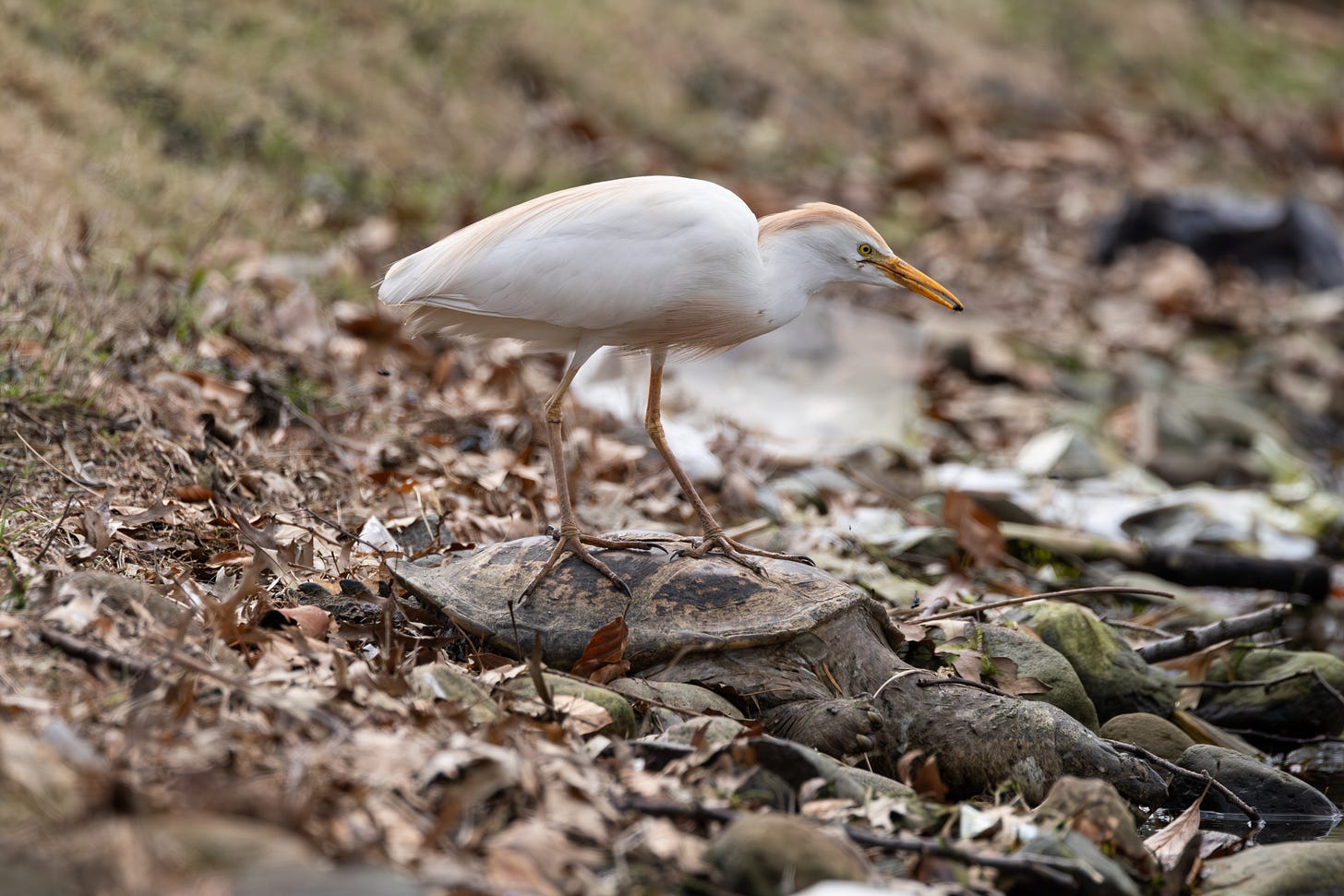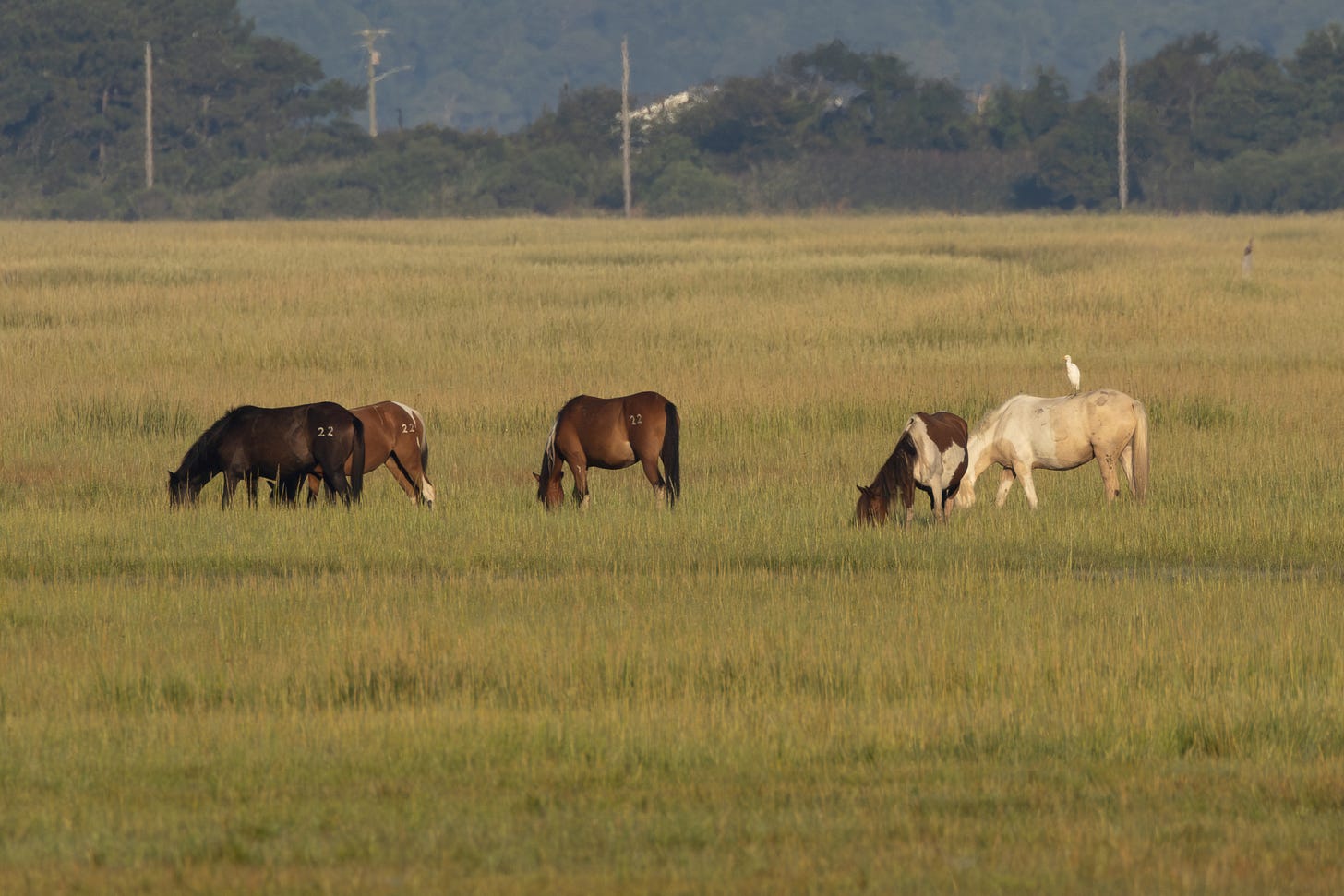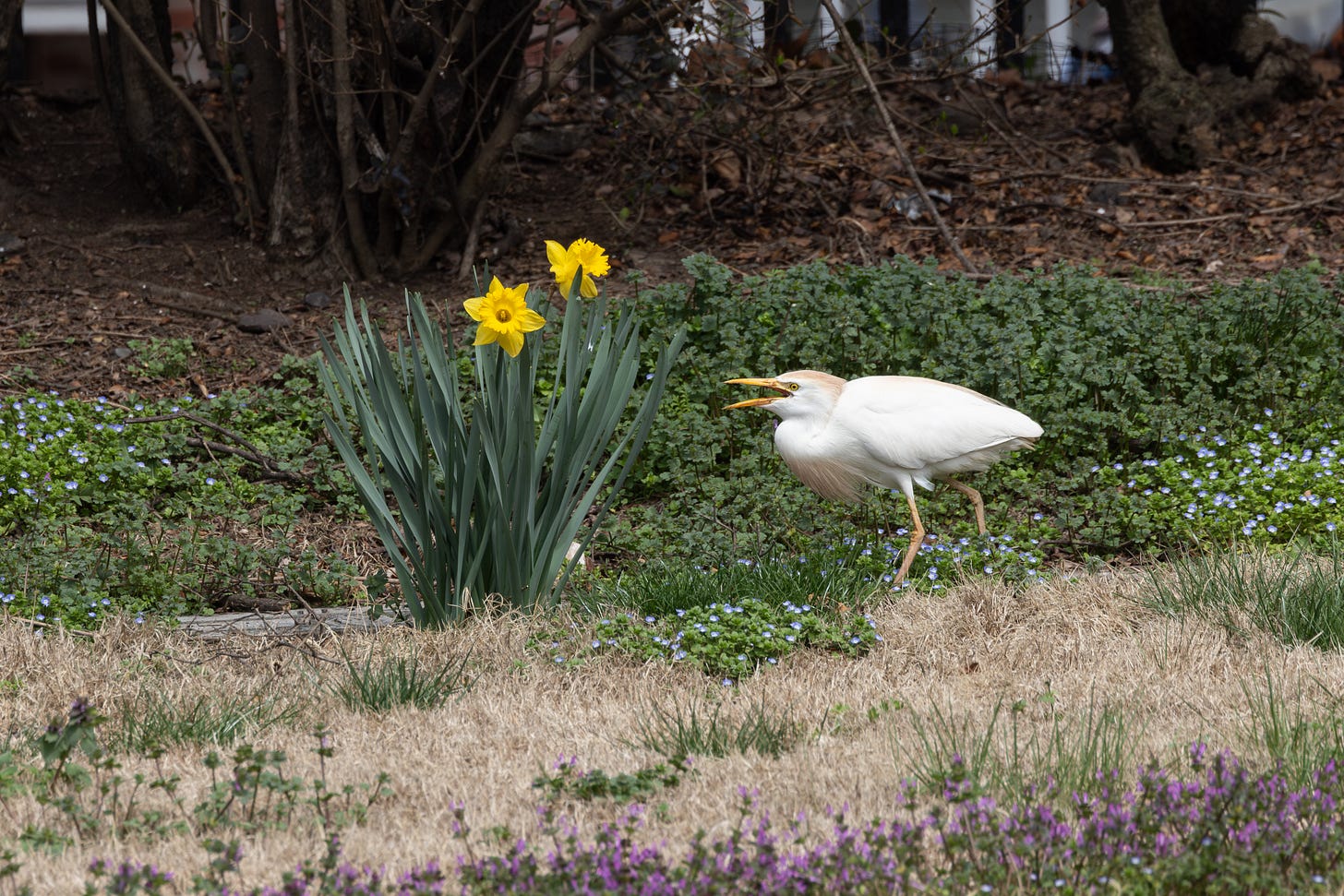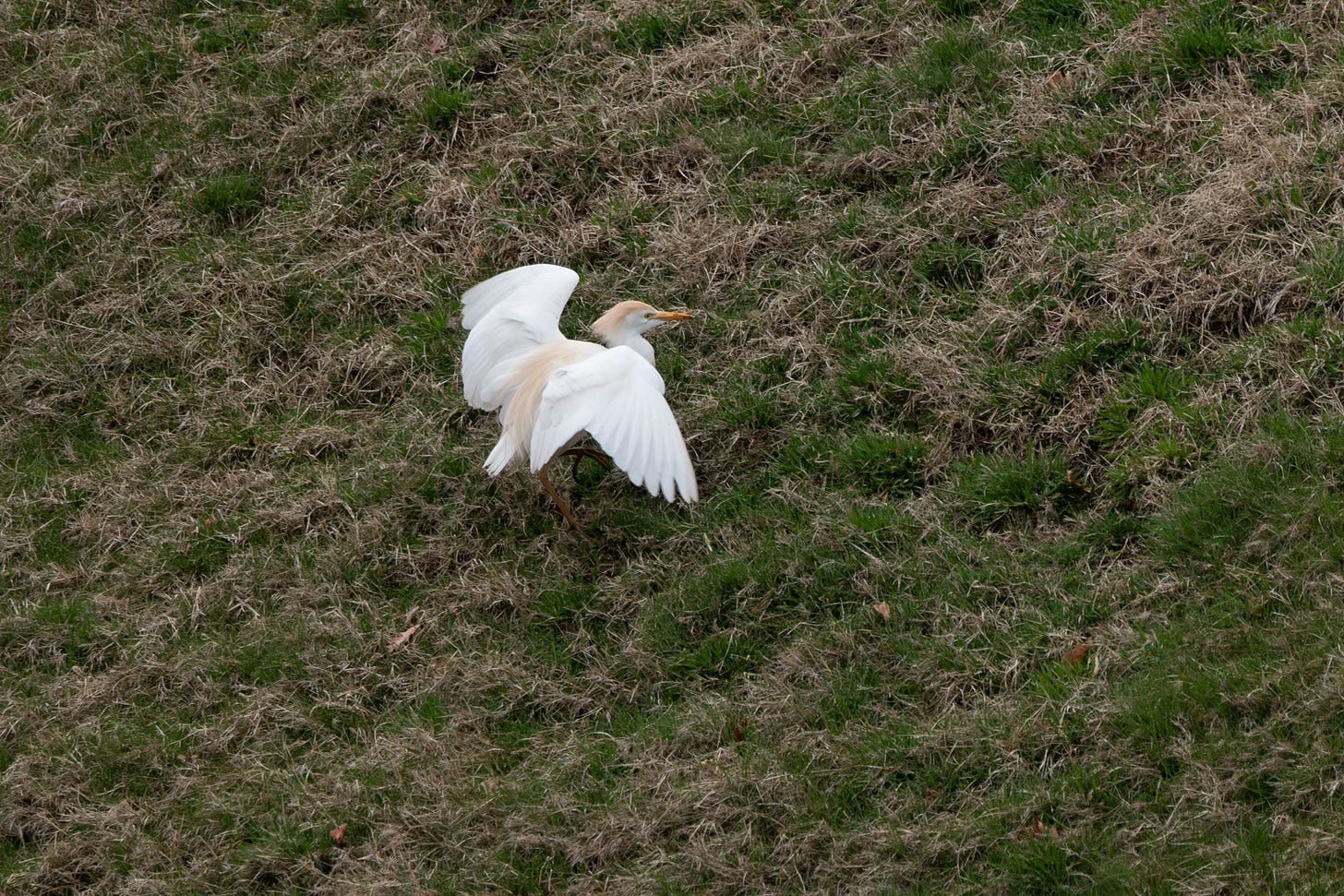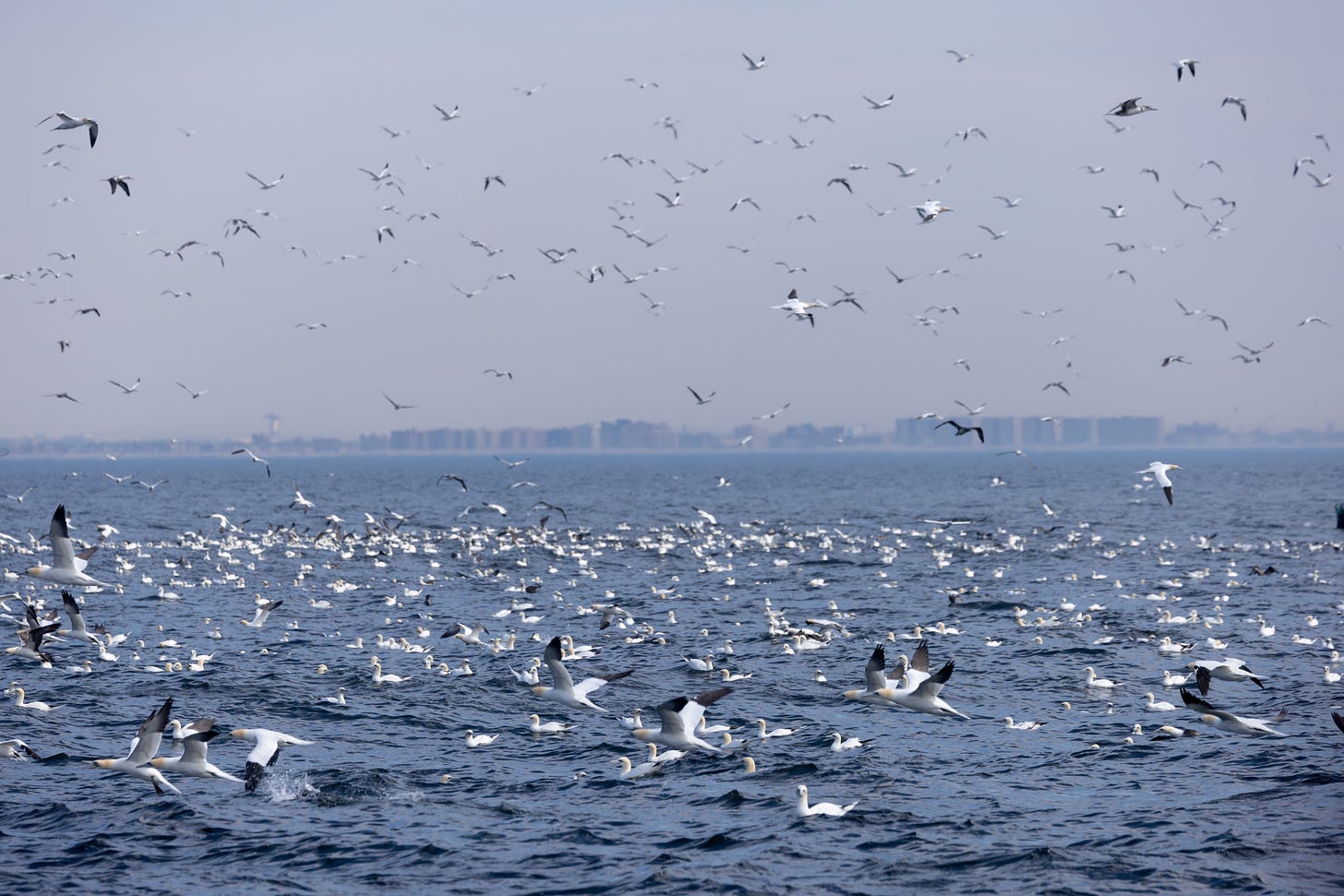yesterday, i was standing at the side of a brooklyn pond when, suddenly, an egret from africa landed beside me and started pecking insects off of a dead snapping turtle. typical, i thought.
enter the wacky world of the cattle egret. two days ago, my friends tripper and daisy spotted a gorgeous breeding plumage male sauntering around brooklyn’s green-wood cemetery. given the holiday (and the fact that i love cattle egrets) i wanted to bang out a post about how one of bird-dom’s strangest creatures took over the world.
herons and egrets are long-legged, long-necked wading birds designed for life snatching fish out of shallow water. but not the cattle egret. at some point in herons’ evolutionary history, one species decided instead to ride around on african buffalo and eat whatever prey the buffalo flushed up. there wasn’t a lot of competition in this niche and it seemed to work well. and soon, cattle egrets took to feeding alongside camels, elephants, rhinos, zebras, anything big that walked through grass. today, there are two species of cattle egrets: the western cattle-egret of africa, europe, and the americas, and the eastern cattle-egret of asia and oceania.
as an aside: mostly the host animals ignore the egrets. but sometimes the egrets get hungry and annoy napping hosts until they wake up and start moving around again. apparantly there is at least one observation of an elephant snatching a cattle egret and slamming it against another elephant, killing the egret instantly, according to birds of the world.
anyway. birds have wings and show up in weird places. it is crazy, but not unprecedented, for a single heron to cross the atlantic—in 2007, an african heron called the western reef-heron spent a summer hanging around the new york harbor.
but that is not the context in which our cattle egret arrived. beginning in the 19th century, western cattle-egrets began breeding beyond africa and southern europe, seemingly by their own decision. observers first reported the species in south america in 1877, and by 1977 they had colonized the whole continent all the way to southern argentina. in the early 1950s they seemed to invade north america, and established themselves as breeding birds throughout the southern half of the united states. by the 1980s hundreds were breeding in new york city. it could be one of the largest and fastest documented natural range expansions of any bird.
perhaps that depends on your definition of “natural,” though. it’s true that young cattle egrets have a propensity to wander—they’re seen regularly at sea, including records in antarctica. wandering birds aren’t enough to establish a new population, though—in addition, recent history has featured widespread forest clearing and cattle farming, often a result of european colonization. so, starting in the 19th century, wayward cattle egrets that would previously have been doomed instead found savannah-like farms with buffalo-like animals flushing up prey all the same.
today, cattle egrets are ubiquitous throughout much of the world, begging for food from people, filling the air over dumps and farms, riding whatever moving thing they can stand on, and bringing their head-bobbing foolishness wherever they go. but cattle egrets have fled new york city as quickly as they appeared. today we only see them as single vagrants or rarely as breeders on isolated islands in the harbor.
it’s likely that the species’ decline across the atlantic coast is equally a reflection of humans—fewer cattle pastures means less cattle egret habitat and fewer cattle egrets. there’s other threats, too—flooding and predation, for examples, plus negative interactions with the humans who were once the reason for their success.
but its interesting: the species is now listed as threatened in new york and in new jersey. one website i saw stated that “conservation and restoration of farmland will be essential to their long-term survival in [new jersey].” but what does it mean to conserve a species fond of human-altered habitat, and is that a priority? does its absence signal a degradation of habitat, or a return to the pre-colonial habitats where cattle egrets didn’t thrive? and which habitat is preferable, from a conservation perspective?
anyway, it is 10:30pm as i write this sentence. these are literally the things that keep me up at night. happy april fools day.
postscript:
i’m about to leave for a week but wanted to write a lil’ something before i left. posting frequency will continue to increase as book stuff picks up—here’s a reminder of my schedule!
bird walk, april 19, 8am @ owl’s head park in bay ridge. free, registration is encouraged.
bird walk, talk, and drag show, april 23, meet 7pm @ sunset stoop in sunset park. we’re gonna explore sunset park, then i’m gonna give a fun intro to nyc nature, my friend alex will do a drag set, and then i’m gonna sign books and do bird readings! it’s like taro but i’ll tell you what kind of bird you are.
pigeon portraits and prose, may 3, 1:30-3:00pm @ caveat. $15, tickets available here. chelsea and i are hosting an irreverent nature writing and illustration workshop called. i am SO EXCITED.
intro to birding, may 4, 9-10:30am @ marine park salt marsh nature center. free, no registration required.
golden hour bird walk, may 8, 6-7:30pm @ prospect park stranahan monument. free, registration encouraged.
wings over wave hill, may 18. bird walk 9:30-11am, bird talk on how to document urban wildlife 4:30-5:30pm. all @ wave hill. free with admission to the grounds.
—
one more thing: it’s gannet migration, and we’re seeing some pretty incredible gannet spectacles off of new york city right now. i took a quick boat ride with britt on the american princess and we get absolutely incredible looks at a feeding frenzy with maybe 5,000 birds. gotta be one of my favorite nyc nature spectacles.



